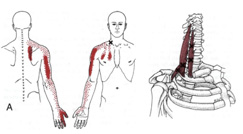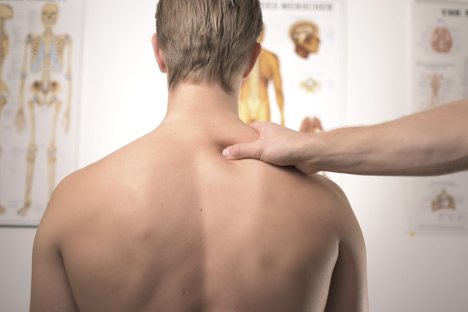In my last post, I described what trigger points actually are and how we get them. You can find that post here.
In this post, we’re going to explore what symptoms of trigger points feel like.
How do I know that I have trigger points?
The fact is, all of us have some trigger points somewhere in our bodies. Whether or not those trigger points are causing us immediate problems is another story. And this is where we differentiate between active and latent trigger points.
Active Myofascial Trigger Points (MTrPs) are hyper-irritable focal points of tension in soft tissue that cause symptoms (I will get more into those symptoms in a moment) whether or not they are being pressed. Latent MTrPs produce symptoms ONLY when they are pressed on.
Here’s how you would experience the difference:
Let’s say you have a deep ache at the front of your shoulder that no matter what you do, how you move or keep still, what position you sleep in, etc, it’s just kind of always there. Sometimes it may be stronger than others, but it’s just there, aggravating you and nothing you seem to do or push on helps it feel better. That’s an active myofascial trigger point.
Now, let’s say you go to see a massage therapist because you are tired of that ache and are hopeful that they can help you. They might start with some work in your pectorals (chest) muscles and when they are working there, they find some “knots” and sink into them and suddenly you feel, “OUCH! That’s very tender! I feel that out to my shoulder and down my arm!” That’s a latent myofascial trigger point. You didn’t even KNOW you had that tender spot until someone pressed on it.
Active trigger points are causing you some symptoms that you feel whether or not you press on that trigger point.
Latent trigger points need to be pressed on for you to feel their effects.
Now that we’ve got that clear, let’s talk about what those symptoms might be.
Symptoms of Trigger Points
The classic symptom of a MTrP is a deep ache. The tricky thing is that the symptoms are often not felt where the trigger point actually is. In the example above, that ache at the front of the shoulder could be coming from the pecs in the chest. It could also be coming from the infraspinatus muscle on the shoulder blade in the back of the body. As a matter of fact, that’s probably the MOST common cause of that deep ache at the front of the shoulder. The area of the body that is hurting is called the pain referral area. The pain referral area could be very far away from the trigger point itself. There is a calf muscle in the lower leg called soleus and this muscle can refer in to the sacra-iliac joint or even into the jaw! Crazy, right? But it’s true and that’s how FAR away from the actual trigger point the pain referral area can live.

Another tricky thing about trigger points is that their pain referral can feel like nerve pain andcompressed nerve symptoms. Trigger points in the scalenes muscles in the neck can produce a radiating ache, numbness, or tingling sensation down the arm and into the fingers. They can also produce aching along the shoulder blade and down into the chest. I have treated people with scalenes trigger points that thought they were having a heart incident because their chest began to ache and their arm starting tingling and going numb. Yes, you should get your heart checked out! And yes, if you get clearance that your heart is OK, you should go see a trigger point therapist and ask them to release your scalenes in your neck!
Sometimes trigger points in certain muscles get diagnosed as a neuralgia.
Neuralgia is pain along the path of a nerve. A common misdiagnosis is trigeminal neuralgia which can be caused from trigger points in the sterno-cleido-mastoid muscle. If you relieve those MTrPs, the “neuralgia” goes away, if the root cause is the trigger points, which is often the case.
Fortunately for us, maps of the pain referral patterns of trigger points in the body have been made and are easily available online. Check out this website Trigger Points.net which gives you those maps. You can look up the muscle itself or the area of your body where you are experiencing the symptoms.
Those maps were created decades ago by the first doctor to really explore these pain patterns, Dr. Janet Travell. Dr. Travell and her colleague, Dr. David Simons, spent years gathering data and researching these pain referral patterns. It took many years for them to produce what is now considered the ultimate resource for understanding trigger points, Myofascial Pain and Dysfunction: The Trigger Point Therapy Manual. This was the first comprehensive literature published on trigger points and their phenomena. You can read more about it here on the website dedicated to the research of Dr. Simons.
More Symptoms of Myofascial Trigger Points
We now know that MTrPs can cause a deep ache and radiating numbness, tingling, sensation, or pain that may feel like neuralgia, or nerve pain. What else?
Trigger points can also cause you a loss of range of motion (ROM) in the affected muscles. If part of your muscle is constantly stuck in contraction, it may be difficult for that muscle to stretch well.
Here’s an example:
You decide to take a yoga class because you keep hearing that yoga can help you feel better and you have a hip issue going on. You go to a beginner class, lay out your new yoga mat, and hope no one asks you to do a split or a handstand! As you are guided through some simple yoga postures, at one point the instructor asks everyone to get into a pose called baddha konasana, where you place the soles of your feet together and let the knees fall out to the side. But when you attempt it, you look at your knees and your right knee lands a few inches higher than your left. WHAT? Yep. And that’s probably the side that you are having your hip thing on. What you are experiencing is a loss in range of motion at the hip joint on the right side and you most likely have some trigger points in the inner thigh muscles, called the adductors. Those trigger points are not allowing your inner thighs on that side to lengthen the same as on the left side, so your knee sits higher.
And here’s another little tricky thing about trigger points, the muscle that is causing our pain referrals if often the END of a tensional system and not even the root cause. You see, in the above example of you trying out yoga and your right knee sitting higher from the ground in baddha konasana, your inner thighs are short and tight and restricted by trigger points. And they are the muscles that are PULLING on your outer hip muscles. The outer hip muscles are MORE LIKELY the ones that are giving you trouble outwardly. You might be experiencing a deep ache in the hip joint, or loss of strength in that hip, or maybe radiating ache or numbness down the outside of the thigh and even into the shin. Those are all symptoms of trigger points in the outer hip muscles, gluteus minimus and medius. But the problem doesn’t start there. It’s the end of the line.
And this is why I encourage you to find a skilled trigger point therapist like our team at FreeBody because a skilled therapist will understand this. They will probably start working on the muscles opposite the ones that are outwardly causing your symptoms because they know that those symptoms didn’t start there, it’s just where the tension met the end of the line.
To close, here is a non- exhaustive list of symptoms that can be caused by trigger points. We couldn’t possibly list ALL of the symptoms in the body but you might be surprised by some that I include here.
List of Common Trigger Point Symptoms:
- Tension headaches
- Some migraines, including those with aura and nausea
- Jaw tension
- Toothache
- Eyestrain
- Ringing in the ears, tinnitus
- Shoulder pain
- Loss of range of motion at ANY joint
- Nerve pain
- Carpal tunnel syndrome
- Knee pain
- Knee buckling
- Hip flexor pain
- Groin pain
- Radiating numbness and tingling down the arms or legs
- Neck pain
- Shoulder pain
- Deep ache in the buttocks
- Sacro-iliac joint dysfunction
- Heel pain
- Weakness in a muscle
- General fatigue (more on that later)
- Elbow pain
- Bursitis (more on that later)
- Trigger finger
- and so much more…
Read more:
Blog: What is a Trigger Point?
Blog: How Do We Get Rid of a Trigger Point?





Thank you. Very helpful information